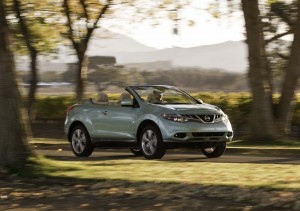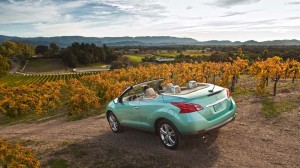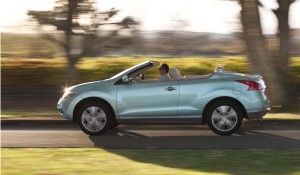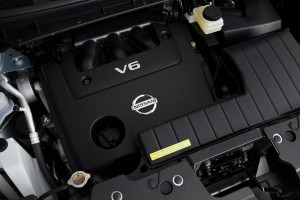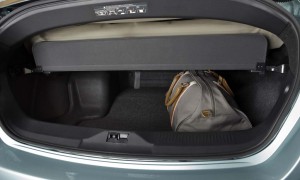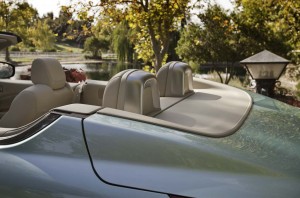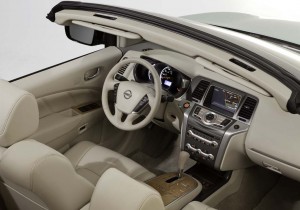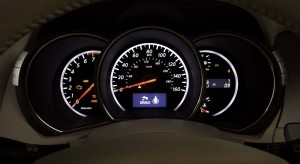Is it a stroke of genius or the answer to a question no one asked? That’s what I was left wondering after getting my first close-up look at the new Nissan Murano CrossCabriolet.
There’ve been plenty of innovations in the convertible world, in recent years, notably the introduction of the fold-away hardtop, which operates like some magical metal origami. But the Nissan CC, as many are bound to call it, goes in a distinctly different direction.
Unless your definition stretches to include the awkward, ungainly and largely unloved Chrysler PT Cruiser Convertible, Nissan has come up with the world’s first crossover convertible. The Murano CrossCabriolet is certainly distinctive, and it fills a niche that nobody else has yet targeted. But whether that matters was the other question I set out to answer during a day of driving through the Nashville countryside near the Japanese maker’s U.S. headquarters.
Nissan has a history of doing things differently, dating back to the days when it stamped “Datsun” on the back of its product. The original Murano itself was a significant addition to the then-emerging crossover-utility vehicle segment. Where other makers played it safe, making their car-based CUVs look like conventional sport-utility vehicles, Nissan opted for a sleekly rounded shape that was more sports car than sport-ute.
Perhaps that was what triggered some early, in-house sketches, back around 2006 that – if legend holds – caught the eye of Nissan CEO Carlos Ghosn’s wife, who reportedly convinced her husband to push ahead with the project.
When word first leaked out, a number of Photoshop artisans offered their own interpretations. Luckily, what we saw popping up across the Internet, usually dubbed “spy shots,” proved largely inaccurate. Nissan designers decided to do more than simply slice off the Murano’s roof which would have resulted in some serious engineering compromises, explained Mike Drongowski, the maker’s senior product planning manager.
The biggest problem with that approach, he said during a walkaround of the CC, would have been the need for a big targa bar to maintain chassis rigidity. This is a fairly large platform, after all, so the alternative was a fairly significant redesign that moves the back of the convertible top forward, about a foot. Beyond that, developers introduced significant bracing to beef up the platform and avoid the need for that cross brace.
The result is a design that maintains the basic looks of the hardtop Murano but has a number of distinctive details all its own, as virtually everything from the windshield pillar back is all new. The windshield itself is more steeply raked than with the hardtop crossover. But most immediately obvious is the shift to a two-door design, with a cargo door that’s not quite hatch and not quite trunk. A distinctive character line has been added to the CC, running the length of the body and flowing into the boomerang-style taillamps.
The 5-section soft-top is the largest on the market, Nissan claims – and it’s hard to think of anything else coming close. Surprisingly, it folds into a space not much bigger than that of the Z Roadster. The maker claims it takes about 25 seconds to operate the top. We clocked it closer to 30, but that’s not enough of a difference to quibble.
To provide a bit more light for back seat occupants, a small skylight has been woven into the roof, just ahead of the glass backlight. It’s a nice feature but we’re betting that under most circumstances, owners will want to keep the top down entirely.
Cargo capacity varies accordingly. With the canvas unfurled you’ll have room for 12.3 cubic feet of cargo. Folded away, that dips to 7.6 cf, still enough to squeeze in tight two golf bags.
Why go for a convertible Murano? One argument is that you maintain some of the key attributes of a CUV, including all-wheel-drive, so-called “command seating,” and a roomy interior. All true, and it’s nice to have a cabriolet that actually can fit four adults who hope to still be speaking to one another after a long drive.
Getting in and out of the back seat is a bit of work, though still easier than with many more conventional 2-door convertibles, like the BMW 3-Series. That’s because the two front doors have been stretched nearly eight inches compared with the conventional Murano.
Nissan is targeting the Murano CC to an affluent and well-educated buyer, typically those with household incomes in excess of $125,000. The maker anticipates getting a bit more distaff buyers than with the standard-issue Murano, where the split is roughly 50/50 male/female.
And it is betting that a sizable share of buyers will be based not just in the Sunbelt but along the Northeast coast, “where people put a premium on sunshine,” suggested Scott Shirley, the program’s marketing director.
A lot can be forgiven when you get to feel the sun on your face and the wind in your hair. Pleasantly, we found that the Murano CrossCabriolet does a good job of keeping the breeze at bay. You don’t get that hurricane blast that many other convertibles experience, meaning it’s pleasant to drive even at highway speeds, especially with the side windows up.
At 4,416 pounds, the Murano CC is several hundred pounds heavier than the standard-issue CUV. While we didn’t have the chance to run our own calibrated tests, it appears the CrossCabriolet will hit 60 in just under 8 seconds, or about a second slower than the hardtop crossover. Fuel economy dips 1 mpg in both the City category, at 17, and Highway, at 22 mpg.
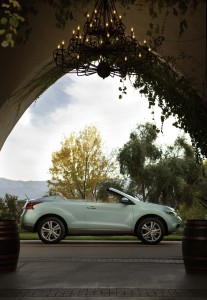
The Nissan Murano will be offered in one trim level, prices starting at $47,200 including delivery charges.
There’s no question the 3.5-liter, 24-valve V6 that powers the CC gets quite a workout. So does the CVT gearbox it’s paired with. Nissan is one of the few makers still relying on continuously variable transmissions, and while it does have some of the drawbacks that have soured other makers, Nissan engineers have done a credible job minimizing such issues as the rubber band effect, where engine and transmission somehow seem to be disconnected during hard acceleration.
All-wheel-drive, by the way, is standard.
Even with all the added bracing the heavier CC doesn’t have quite the rigidity of the quite sporty Murano hardtop. But, then again, the convertible is reasonably solid and handled hard cornering more confidently than we might have anticipated. There’s virtually no column shake even on rough pavement.
At $46,390 – plus $810 for delivery charges – the 2011 Nissan Murano CrossCabriolet isn’t cheap. That’s about $18,000 more than the base Murano and a more than $5,000 premium over the Murano LE, the top-line hardtop edition that carries a similar level of equipment.
Nissan decided to go with a single, heavily-loaded version of the CC, which means plenty of wood and leather, a large, dash-mounted Navi, a great audio system and more.
Formally unveiled at last November’s Los Angeles Auto Show, Nissan claims to have already recorded 1,100 orders for the new Murano CrossCabriolet, and another 6,700 “hand-raisers” whom it hopes to convert into happy customers.
And if our day of driving is any indication, the maker will be lining up still more shoppers after they see a Murano CC go by. No question, the CrossCabriolet draws plenty of strange glances, but it also generated a sizable number of thumbs-up and waves as we drove by.
True, there likely weren’t many motorists asking for an all-wheel-drive crossover convertible, but the best makers are those that can answer product questions before they’re asked. The CC is clearly set to appeal to a small niche of buyers, but it will likely also draw plenty of attention to the rest of the Nissan line-up.

